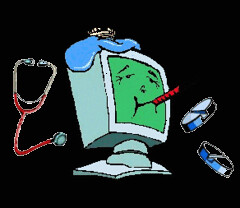If you have used a Windows machine for a while, whether it's Windows XP, Windows 2000 you're sure to have noticed desktop icons appearing from out of nowhere. How can icons mysteriously emerge on your Windows desktop?
1. When you buy a computer, many vendors place icons to selected products and services on your desktop, such as links to high-speed Internet Service Providers (ISPs) or add-on services vendors think you may need.
2. As you install software on your Windows machine, icons may appear, either to start the application or link to the manufacturer's website. Installing just one program could add three or more icons to your desktop!
3. It's easy to accidentally drag a Favorite, bookmark, text file, or other icon to your desktop, creating an icon.
Normally, it's easy to delete Windows desktop icons. Just place your mouse pointer on the offending icon, then right-click it and choose "Delete", clicking "Yes" to confirm if prompted.
However, what if the rogue icons are for adult websites, unfamiliar search engines, or other websites you don't recall visiting? You may try removing these icons but get an error, or after removal they still reappear again and again and again!
If so, then more than likely spyware, adware, or other malware has infected your machine. It may have been through file trading software, an inadvertent "yes" click when a popup window asked you to install software, 'freeware' that included adware, or other means. To remove the rogue icons, you need to remove the malware creating these icons.
Removing spyware and adware can be a time-consuming process, fraught with potential disaster as it is possible to accidentally remove files that render your operating system unusable. However, the following software products can help with this process as long as you read the instructions carefully, make backups, and get expert advice if you're not completely sure about removing what they ask you to do:
* Ad-Aware: http://www.lavasoft.com/
* Microsoft Windows AntiSpyware: http://www.microsoft.com/athome/security/spyware/software/
* Pest Patrol: http://www.pestpatrol.com/
* Spybot Search and Destroy: http://safer-networking.org/
* Spy Sweeper: http://www.webroot.com/
So, how can you prevent these icons from appearing in the first place? Practice safe computing.
* Backup your machine. If it does get infected to the point of being unusable, at least you won't lose all your important files.
* Install security-related operating system updates so spyware and adware cannot enter your system through well-known exploits.
* Download or buy a virus scanner, and keep it updated! Virus scanners cannot detect all spyware, but it doesn't hurt to have one. Check online or visit your local computer software store.
* Purchase a hardware or software firewall, and keep it updated! Firewalls help protect your computer from common exploits that spyware or adware can use to infect your machine.
* Consider using a different web browser. Though it is not perfect, Mozilla Firefox is currently less susceptible to spyware than Internet Explorer, mainly because it lacks certain technology (such as ActiveX) that is often exploited by malware writers. Note that depending on your web use, certain websites may not work correctly with other web browsers.
By practicing safe computing and using spyware-removal software, you can help remove rogue desktop icons from your desktop and keep others from appearing.
Andrew Malek is the owner of the MalekTips computer and technology help site. Visit his anti-spyware page for more advice on removing adware, spyware, and other malware.
